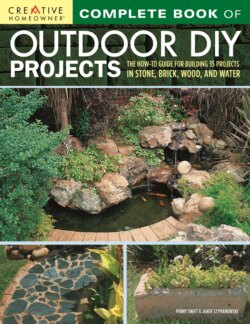Читать книгу Complete Book of Outdoor DIY Projects - Penny Swift - Страница 7
На сайте Литреса книга снята с продажи.
ОглавлениеPLANNING & DESIGN
Designing a garden can be a daunting task, particularly if you are starting from scratch. Paths, steps and patios form the skeleton of a garden, while walls, fences and hedges contain it and offer an opportunity to divide it. While plants are vital to a garden scheme, structures may also be considered for aesthetic reasons and to make the outdoor area more functional. Ultimately, you should aim for unity and harmony and try to choose materials that will suit the house and blend in with the style of the garden.
Type and style
There are two basic garden types – formal and informal. Likewise, features and structures may also be categorized this way. Garden style, on the other hand, may relate to architecture, a period look, or even a style suggested by a common approach in a certain country or area like Japan or the Mediterranean countries. Certain styles are also often linked to basic garden types. A cottage-style garden, for instance, may be informal, while a garden modelled on meticulously laid out Italian villa gardens will be formal, even if it is not as grand.
Primarily, the layout determines a garden type, but structures and style of planting should also keep with the look. So, too, should the materials for structures or surfacing a garden floor. While steps in a formal garden may follow straight lines and will usually be built from brick, informal staircases will be less rigid, utilizing stone or lumber. Lumber in a formal garden may be neatly sawed and even painted.
The plan
It does not matter whether you are starting from nothing or simply building features that will improve the look of your garden, sketch the area and draw in walls, buildings, fences, and so on, as well as established trees, boulders, and other existing features. You will also need to note any sloping ground. Draw the plan to scale. If possible, spend time in the garden, noting sun patterns and prevailing winds and indicate these on the plan. Also mark views and buildings that overlook your property. This will help identify locations for paths, steps, patios, walls, and other structures.
The location
One of the most important elements of building a garden structure is choosing the most suitable location. Almost all these projects are permanent structures that cannot be moved, so consider the advantages and disadvantages of each. Try to visualize the finished feature in the site you have chosen, and then reconsider your plan if necessary.
Consider all the options
Plans and locations depend almost entirely on individual gardens. For instance, the obvious route for a path may be from the gate to the front door, but if it bisects a lawn, you may prefer it to curve around an existing flower bed or, if the garden is on more than one level, link the path to steps.
Plan walkways and features so that they blend with and enhance the architectural lines of your home.
The location of a pond depends on local conditions (including soil), gradient of the land, and the existence of rocks and established plants. Areas with natural boulders and secluded corners on lower ground lend themselves to ponds and pools. If the ground slopes, you could include a rock garden alongside the pond, or build a retaining stone wall instead. Unexciting shady areas may benefit from water features, although roots can make digging difficult and some trees lose their leaves in autumn.
Planters are like small gardens on their own and may be built in any number of locations – under a window, as part of a boundary wall, against a patio wall, or even in the center of a driveway or in the garden itself.
Practical decoration
While fences are generally made to enclose a property, they may also be built within the garden itself. Decorative picket fences can enclose a vegetable and herb garden, but may also be erected along a boundary – although be absolutely sure you know where the official boundary of your property lies. You may also need to get consent from your neighbors, who may automatically share ownership of the fence (or wall) even if they do not contribute to the cost of it.
A rustic screen may make a patio more private or shield an entertainment area from prevailing winds. Before you start digging foundations, check whether there are any legal restrictions in terms of the height of the wall and its location. One can usually build small brick structures within the garden without approval, but walls and pillars to support an arbor roof, for example, may require plans. If you do need approval from your local authority, make sure that you do this before you rush out to buy materials.
